On the trail of naive artists: Sunday tour of the Lindenau Museum!
Sunday tour on November 9th, 2025 in the Lindenau Museum: Discover naive artists from Altenburg and their works. Admission free!

On the trail of naive artists: Sunday tour of the Lindenau Museum!
On Sunday, November 9th, 2025, there will be an exciting Sunday tour in the Lindenau Museum Altenburg that deals with the naive artists from Altenburg. The event will begin at 2 p.m. and will be led by Angelika Forster, a former art educator at the museum. Entry is free.
A central focus of the tour is on the watercolors and autographs by Christian Friedrich Schadewitz (1779–1847), whose works document social events in Altenburg in the 19th century. In addition to Schadewitz, the “Painters of the Sacred Heart” from the 20th century are also taken into account, including Helene Handel, Ernst Ehm, Emil Klinger and Ulrich Pröhl. These artists often began their careers late, and their works depict both historical events and intimate portraits.
Naive art: A special form of creativity
The term “naïve art” refers to artistic work by self-taught artists, especially in painting. This movement gained importance in Paris from the late 19th century onwards and was largely popularized by art historians such as Wilhelm Uhde. The most famous artists of Naïve Art include Henri Rousseau, Séraphine Louis and Camille Bombois, all of whom were brought into the spotlight by Uhde's “Painter of the Sacred Heart” exhibition in the 1920s. In Germany, the important autodidact Adalbert Trillhaase deserves special mention, whose works were considered degenerate during the Nazi era.
Naïve art has received considerable attention in recent decades, with Kovačica in Serbia considered the mecca of this art form. Other art objects such as painted pumpkins and handcrafted dolls are also made there. In Germany there are important collections in cities such as Cologne and Neuss that highlight the diversity and richness of this art form.
Insight into life stories and works
The Sunday tour in the Lindenau Museum is not just about works of art, but also about the life stories of the artists. Examining their biography and the social contexts in which they worked gives participants a deeper insight into the world of naive art. While there is increasing discussion in the art scene about discrimination and the demarcation between academic and non-academic art, this tour is an opportunity to recognize the relevance of naive art in today's world.
In addition, modern discussions, for example by art critics such as Jerry Saltz, highlight the need to question the separation between outsider art and institutionalized art. This promotes the integration of non-academic art into museums and opens new perspectives on the meaning of these works.
The Sunday tour in the Lindenau Museum offers an ideal opportunity to immerse yourself in the world of naive art and find out about the often underestimated artists and their works. Visitors are warmly invited to go on this discovery tour with Angelika Forster and to explore the historical, artistic and human aspects of the Altenburg picture painters.
For more information about the event and Naive Art in general, we refer to the articles by abg-net.de and the comprehensive details Wikimedia. You can also find a discussion about the spelling of the term “naïve” and its historical context Stack Exchange.

 Suche
Suche
 Mein Konto
Mein Konto
